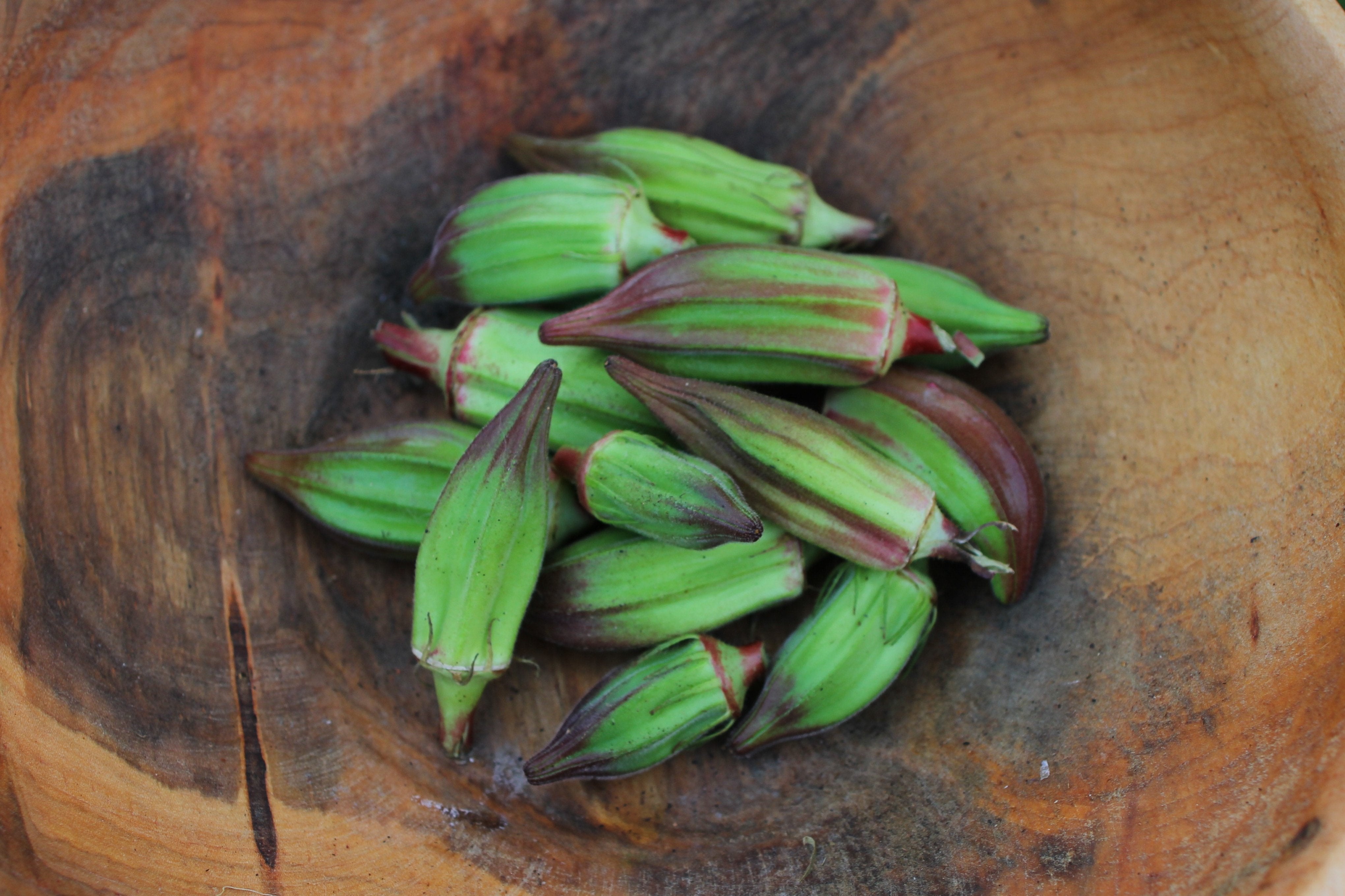Okra, Abelmoschus esculentus
If you’re not an okra lover, read on, okra is amazing. If you are an okra lover, read on, you may not be tapping into its full potential. I’m going to tell you why okra is amazing (to get you fully on board), and then I’ll tell you how to take it from seed to seed.
From a single planting, you can extract the following yields:
Greens: Okra leaves are entirely edible, good for fresh eating in their very young stage, but more often used as a cooking green where the heat removes any spikiness. They can be used as thickeners in soups or powdered for winter storage for use in smoothies, soups and stews.
Pods: We eat the immature pods before they go ‘woody’. The number of pod preparations is astounding and I fully believe anyone who doesn’t enjoy okra just hasn’t had it cooked right. You can ferment, pickle, freeze and dry okra for winter use. Note: I have been pasteurizing the woody dried pods (once I’ve extracted the seeds) and inoculating them with oyster mushroom mycelium for a secondary crop prior to giving the spent mushroom block to my worms. The mycelium breaks down the tough okra pods to a point where the worms can turn them into vermiculture quite quickly.
Flowers: The flowers are beautiful and have an okra-y-asparagus taste. They can be prepared along the same lines as squash flowers, but are also good raw. Okra flowers are perfect (botanically), so you’ll be sacrificing pod development. Since as most okra growers complain of overproduction, eating the flowers can be a great way to slow it down! Note: the flowers are big and beautiful and attract and feed pollinators.
Seeds: Okra varieties have a variable oil content in their seeds, but I have successfully pressed them for a light, citrusy, olive oil like oil with a yellow-green hue. The mature seeds can be roasted and ground for a rich, nutty, gluten-free, high protein flour. I’ve made pie crusts, pizza bases and crackers with the flour and the flavor is excellent, almost coffee-like.
Structure: Okra has an incredibly aggressive root network, with 4.5 ft taproots at maturity and wide, dense lateral roots. The opportunity for injecting organic matter deep into the soil is huge. The top growth can support beans in season, peas during the winter (I’ve had dead stalks stand all winter) and the bast fibre makes a very strong cordage. The center of the stalk has been used to make fine quality paper.
As I said, okra is amazing! So, how do you grow it?

Growing Okra
Okra is an easy to grow frost sensitive annual. It prefers to be direct seeded when the soil has had a chance to warm, and soaking the seeds overnight can improve germination rates. Because of the aggressive and expansive root system I mentioned above, 12-18” spacing will increase your yields (don’t skimp on the spacing). Okra is drought tolerant and can cope with relatively poor soils (although as with most vegetables, it will be happier with better soil).
Okra is self supporting and rarely needs staking, although some varieties are prone to lodging under heavy yields. The okra flower opens for one day only, after which a small pod will form and grow behind the dead flower. Pod production begins about 2 months after planting and, if you keep harvesting, will continue until the first frost kills the plant. In peak production it is best to harvest every other day to stay on top of production. However, if you can’t keep up, remember you can eat the flowers, or let the pods go big and woody so you can process the seeds for eating or saving.
Saving Okra Seed
Okra flowers are perfect, meaning they can fertilize themselves. As seeds savers this is good news because it keeps things pretty easy. Okra flowers are also big and beautiful, meaning they attract pollinators. This can present a challenge for seed saving because okra will cross pollinate with other okra varieties over ½ a mile!
If you are just growing one variety of okra and your near neighbors are not growing okra, then don’t worry. All the seed you save will grow true to type i.e. your Clemson Spineless okra seed will continue to grow Clemson Spineless okra. If you or your neighbor are growing another variety then you will need to bag your flowers. This is not as scary as it sounds. Sow True Seed has 2”x3” isolation bags which fit over an unopened okra flower. The flower will open inside the bag and wind or a slight tap will be enough for successful fertilization. Once the flower dies the bag can be removed and a ribbon tied around the pod’s stem so you’ll know which pods have pure seed. Bag and label a couple of pods on each of your healthiest plants and you’ll have more than enough seed for planting and trading. As with beans, the pods want to dry to full maturity on the stalk, but if rain threatens late in the process then cut the whole plant and finish drying inside.
Ready to get growing? Check out our full collection of okra seeds here!
| |
Article Written by: Angie Lavezzo |
|
About the Author: Angie Lavezzo is the former general manager of Sow True Seed. Beyond her professional role at Sow True, Angie's passion for gardening extends into personal hands-on experience, fostering plants and reaping bountiful harvests. |


